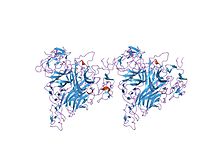Tumour necrosis factor
| TNF (Tumor Necrosis Factor) family | |||||||||
|---|---|---|---|---|---|---|---|---|---|

Trimeric structure of TNF alpha, produced by Mus musculus, based on PDB structure 2TNF (1.4 Å Resolution). Different colors represent different monomers. Baeyens, KJ et al. (1999). Figure rendered using FirstGlance Jmol.
|
|||||||||
| Identifiers | |||||||||
| Symbol | TNF | ||||||||
| Pfam | PF00229 | ||||||||
| InterPro | IPR006052 | ||||||||
| PROSITE | PDOC00224 | ||||||||
| SCOP | 1tnf | ||||||||
| SUPERFAMILY | 1tnf | ||||||||
| OPM superfamily | 357 | ||||||||
| OPM protein | 2hew | ||||||||
|
|||||||||
| Available protein structures: | |
|---|---|
| Pfam | structures |
| PDB | RCSB PDB; PDBe; PDBj |
| PDBsum | structure summary |
| TNF | |||||||||
|---|---|---|---|---|---|---|---|---|---|

crystal structure of trail-sdr5
|
|||||||||
| Identifiers | |||||||||
| Symbol | TNF | ||||||||
| Pfam | PF00229 | ||||||||
| Pfam clan | CL0100 | ||||||||
| InterPro | IPR006052 | ||||||||
| PROSITE | PDOC00561 | ||||||||
| SCOP | 1tnr | ||||||||
| SUPERFAMILY | 1tnr | ||||||||
|
|||||||||
| Available protein structures: | |
|---|---|
| Pfam | structures |
| PDB | RCSB PDB; PDBe; PDBj |
| PDBsum | structure summary |
The tumor necrosis factor (TNF) superfamily refers to a superfamily of cytokines that can cause cell death (apoptosis).
The first two members of the family to be identified were:
Nineteen proteins have been identified as part of the TNF family on the basis of sequence, functional, and structural similarities. They include:
All these cytokines seem to form homotrimeric (or heterotrimeric in the case of LT-alpha/beta) complexes that are recognized by their specific receptors. Strong hydrogen bonds between the monomers stabilize the tertiary structure. One such example is the Asn34-Arg82 hydrogen bond in the M. musculus TNF alpha. The PROSITE pattern for this family is located in a beta-strand in the central section of the protein that is conserved across all members.
All members of the TNF family, with the exception of the secreted lymphotoxin and a proliferation-inducing ligand (APRIL), are type II transmembrane proteins that protrude from immune cells. Such membrane-bound TNF ligands frequently signal back to the immune cells when they contact and bind their cognate receptors on other cells.
Human proteins containing this domain include:
This article incorporates text from the public domain Pfam and InterPro IPR006052
...
Wikipedia
